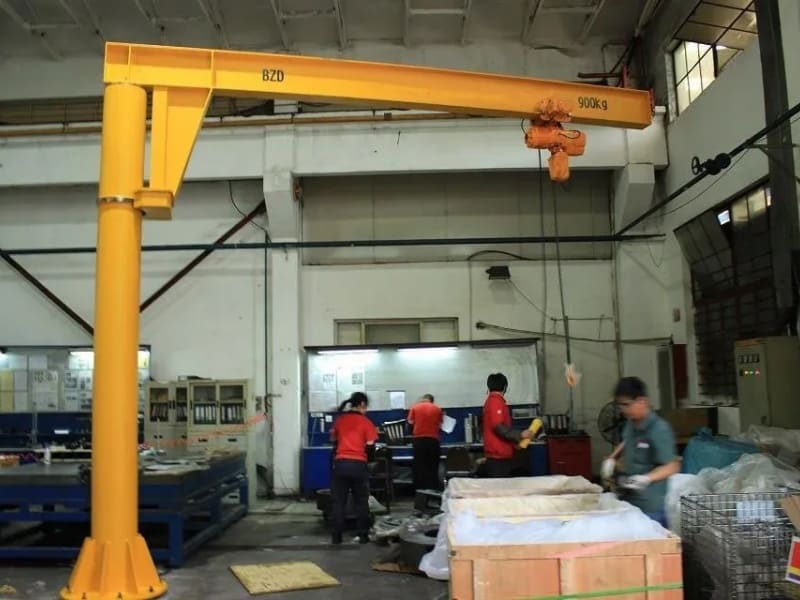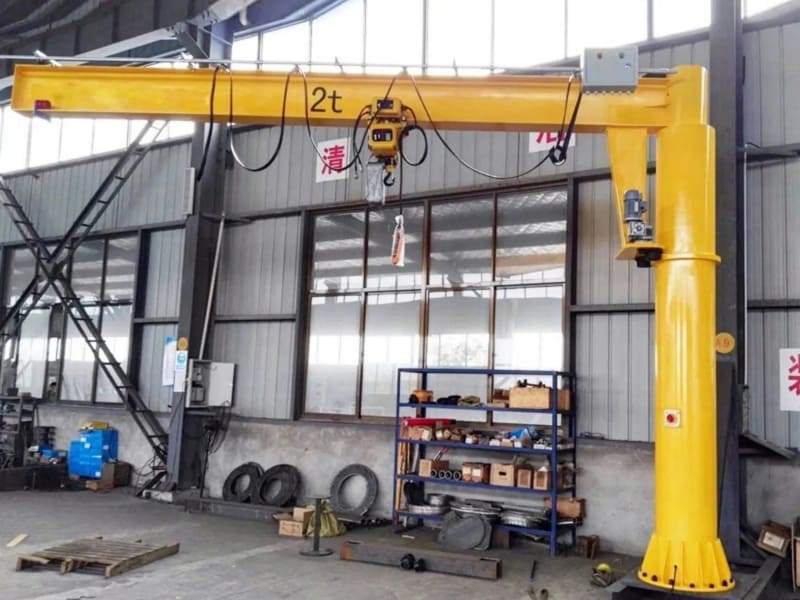Floor mounted jib crane is a small and medium-sized lifting equipment with unique structure, safety and reliability. It is characterized by high efficiency, energy saving, time-saving, flexibility and flexibility. It can be operated freely in three-dimensional space. It is more convenient than other conventional cranes in the case of segment distance and dense transportation. The equipment also shows its superiority. Widely used in different places in various industries.
Pillar jib cranes are widely used in workshops, warehouses, docks, yards, storage, and other places where the pillar can be installed. Pillar jib crane shows superiority when used in short-range or serried applications. However, they are forbidden to be used in dangerous applications where are inflammable, explosive, and corrosive, etc.
Advantages of Pillar Jib Crane
Pillar jib cranes are widely recognized as one of the most practical lifting solutions for workshops, warehouses, and industrial facilities. Their design combines strength, flexibility, and efficiency, offering a wide range of benefits that make them a preferred choice in many industries.
Compact Design: The compact structure of a pillar jib crane ensures light dead weight while maintaining excellent performance. Its space-saving design allows for maximum utilization of available floor and overhead areas, enabling smoother workflow in confined spaces. The reduced hook approach distance further optimizes operations, making it an ideal material handling solution for areas with limited room.
Smooth and Fast Operation: Equipped with a stepless frequency conversion control system, the freestanding jib crane provides stable braking, precise positioning, and reliable performance. The smooth acceleration and deceleration minimize load swing and enhance safety, while steady travel and accurate positioning increase efficiency in loading and unloading operations. These features make the crane particularly suitable for repetitive handling tasks where speed and reliability are crucial.
High Safety and Reliability: Pillar jib cranes are designed with advanced safety technologies to ensure consistent and secure operations. Perfect braking systems improve safety by providing stable stopping power, while dustproof designs extend the service life of key components. In fact, the braking system is designed for up to one million operations, ensuring long-term durability with minimal maintenance.
Low Maintenance and Durability: Thanks to hardened and polished gear tooth surfaces, the crane operates smoothly with minimal wear and tear. This free-maintenance design reduces downtime and lowers the overall cost of ownership. Operators can rely on the crane for continuous operation in demanding environments without frequent servicing.
Energy-Saving and Efficient: The modern design of the pillar jib crane emphasizes energy-saving operation while maintaining high lifting efficiency. Its advanced control system optimizes power consumption, helping reduce operational costs while delivering consistent performance.
Factors to Consider While Selecting a Jib Crane
When selecting a jib crane, careful evaluation of several factors ensures that the equipment is both efficient and reliable for the intended application. Key considerations include:
Capacity: The lifting capacity determines the maximum load the crane can handle, usually specified at the tip of the jib arm. Choosing the correct capacity is essential to avoid overloading, which could compromise safety and reduce the crane’s lifespan.
Height Under Hook: This refers to the distance from the floor to the underside of the hook. It dictates the maximum height of an object or machine that can be accommodated under the crane. Ensuring adequate clearance is critical for efficient lifting operations.
Overall Height: The total height of the freestanding jib crane, including any attachments, should be considered. Adequate space must be ensured to avoid interference with overhead structures, allowing for full boom rotation and smooth operation.
Boom Rotation: Freestanding, mast-type, or pillar-mounted jib cranes can offer up to 360-degree rotation. However, if obstructions limit movement, the required rotation range must be specified during selection to ensure compatibility with the operating environment.
Electric Motion Requirement: Depending on the application, the crane can be configured for manual or electric operation of its lifting, slewing, and traveling motions. Defining this in advance ensures the crane meets operational needs.
Weatherization: For outdoor use, both the structure and electrical components may need weatherproofing to withstand harsh environmental conditions and ensure long-term durability.
Installation Considerations: Site conditions strongly influence the type of jib crane suitable for installation. For example, pillar-mounted cranes require reinforced concrete foundations, which may represent a significant portion of the investment. Proper site assessment ensures safe and cost-effective installation.
By thoroughly evaluating these factors, businesses can select the most appropriate jib crane for their needs, balancing performance, safety, and cost efficiency.
In summary, pillar jib cranes offer a perfect balance of compact structure, operational efficiency, safety, and long-term reliability. They are the ideal lifting solution for industries that require flexibility, high performance, and cost-effective material handling.









